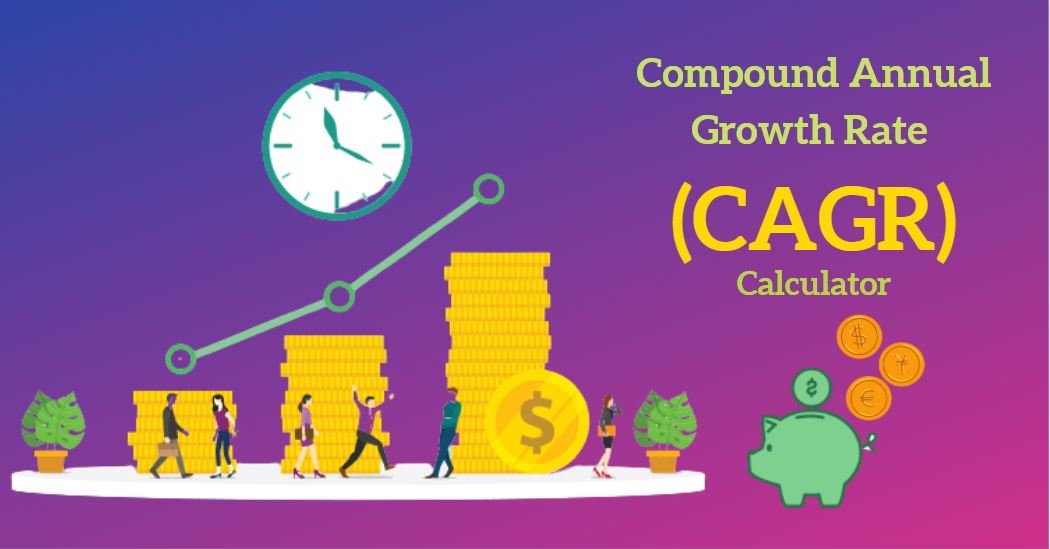A Comprehensive Guide To Compound Annual Growth Rate (CAGR) Calculator
There are a variety of different tools you can use to compare investment to see which one is likely to offer you with best returns. CAGR, gives you a hypothetical consistent growth rate for an investment is one of the most effective. The Compound Annual Growth Rate formula is used to calculate this application. CAGR is a helpful metric of investment growth (or decline) over time for investors. So, with our quick guide, let’s explore everything there is to know about the compound annual growth rate.
What Is CAGR?
The CAGR stands for Compound Annual Growth Rate. The compound annual growth rate (CAGR) is a measurement of your investments’ average annual growth over a set period of time. It shows you the average rate of return on your investments over the course of a year.
It’s vital to keep in mind that the compound annual growth rate calculation does not yield a real return rate. Rather, this provides you with a representational figure of how much your investment would have increased if it had risen at the same pace every year.
The CAGR Calculator is a free online tool that allows you to calculate the compound annual growth rate of your investment over time. Enter the starting value or initial investment amount, the predicted ending value, and the number of months or years for which you want to calculate the CAGR for your investment. After that, click the calculate option to allow the online CAGR calculator figure out the result. This shows you how much your initial investment has grown over time, as well as a bar chart for a more detailed representation of your annual or periodic progress.
The CAGR Formula-
The Compound Annual Growth Rate formula is:
CAGR = (Ending balance/beginning balance)1/n – 1
Where:
Ending balance: The value of the investment at the end of the investment period.
Beginning balance: The value of the investment at the starting of the investment period.
N: the number of years that you have invested.
Let’s take a hypothetical example.
In 2015, you invested Rs.20,000 in a mutual fund. In 2020, the investment will be worth Rs.35000. The CAGR of this mutual fund investment will be calculated using the formula:
CAGR= (35000/ 20000) ^ (1/5) – 1 = 11.84%
The results show that your mutual fund investment yielded an average return of 11.84 percent per annum.
What Are The Advantages of CAGR?
Some of the advantages of using a CAGR calculator are listed below.
- It is a useful tool for determining the profitability of investments over a certain period.
- CAGR allows investors to compare investments over different time horizons.
- CAGR allows you to compare investment profits to risk-free assets. This also allows you to determine whether the risk premium is big enough.
What Are The Disadvantages of CAGR?
CAGR is a very useful tool, there are a few drawbacks to be aware of.
- CAGR does not take into account investment risk.
- Because CAGR reflects a constant growth during the investment period, it does not reflect the volatility of the investment value. A consistent rate of growth is also implied by CAGR.
CAGR vs Absolute Returns
The goal of investing is to make money. Returns on an investment can be expressed in a variety of ways. Absolute returns are a measure of an investment’s entire return, regardless of the time period. The compound annual growth rate (CAGR) is the rate of return on an investment over time. The return on an investment is calculated using both absolute and compounded annual growth rates. It’s crucial to understand how your investments have done on an average year-over-year basis as an investor. In this circumstance, CAGR can be really useful.
How Is CAGR Calculated?
To calculate CAGR, the formula above is dependent on three variables: the beginning value, the end value, and the number of years (N). Use the CAGR calculation formula to calculate the compounded annual growth rate (CAGR) and follow these steps:
- Divide the investment value at the end of the period by the beginning value.
- Increase the result to the power of one divided by the investment’s period in years.
- Subtract one from the result.
Now with this, you can determine the CAGR for your investments.
Frequently Asked Questions (FAQs)
When to utilize CAGR?
CAGR can be used to compare the performance of several mutual funds and estimate their earning ability. CAGR may take into account the investment period, providing you a more realistic view of your mutual fund earnings. CAGR can be used to compare the returns of bonds, stocks, or mutual funds over time. It allows you to track your investment results over time.
Why is CAGR used?
On periodic investments, the CAGR reduces the impacts of volatility. CAGR can be used to calculate the performance of an investment over a three to five-year period. CAGR depicts the geometric mean return while taking compound growth into consideration. CAGR aids in the calculation of your investments’ internal rate of return.
Which one is better IRR or CAGR?
CAGR is a better indicator of performance than IRR. IRR and CAGR can be used for several objectives. CAGR depicts the return on your investment over time. IRR, on the other hand, can be used to calculate the return on complex projects and investments with a variety of cash inflows and outflows.
When you invest in a lump sum, the IRR and CAGR are just the same. When you have various investments and varied annual returns, they will be different. In a short, IRR may be used to calculate the return on various cash flows investments.
What is the CAGR Ratio?
A geometric progression ratio can be looked as a CAGR. The compound annual growth rate (CAGR) is a prominent financial ratio for comparing investment returns. To determine which is the best investment, the CAGR Ratio analyses returns over time. You can select the investment that has the highest CAGR.
Is CAGR used in banking?
The compound annual growth rate, or CAGR, depicts the actual return on an investment. CAGR is more commonly used to calculate returns from mutual funds and stocks than for banking. Rather than CAGR, consider annualised yield in banking. It’s the amount of interest you get per year on your overall investment.
What is the difference between XIRR and CAGR?
When making a one-time investment, you may consider CAGR to be accurate. You can invest in mutual funds via a structured investment plan, or SIP. The earnings percentage for each investment term would be different, and CAGR fails to represent the correct earnings percentage over cumulative investment tenures. For multiple investments made with the same SIP across the investment tenure, XIRR may be considered. XIRR is an aggregation of numerous CAGRs.




